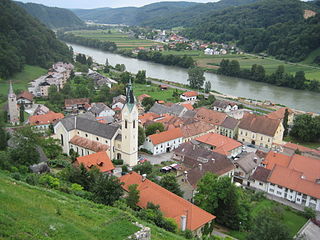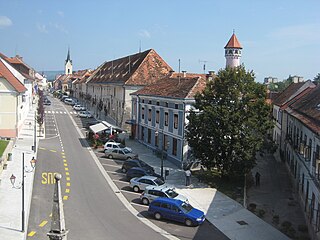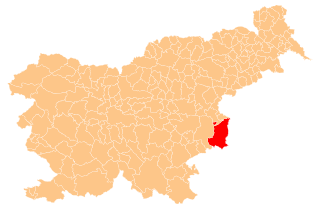This article needs additional citations for verification .(March 2008) (Learn how and when to remove this template message) |

The Lower Sava Valley (Slovene : Posavje, also Spodnje Posavje and Posavska regija [1] ) is a region in southeastern Slovenia on the border with Croatia. It has three major urban centers: Brežice, Krško, and Sevnica. Its borders are almost identical with those of the Lower Sava statistical region.

Slovene or Slovenian belongs to the group of South Slavic languages. It is spoken by approximately 2.5 million speakers worldwide, the majority of whom live in Slovenia. It is the first language of about 2.1 million Slovenian people and is one of the 24 official and working languages of the European Union.
In geography, regions are areas that are broadly divided by physical characteristics, human impact characteristics, and the interaction of humanity and the environment. Geographic regions and sub-regions are mostly described by their imprecisely defined, and sometimes transitory boundaries, except in human geography, where jurisdiction areas such as national borders are defined in law.

Slovenia, officially the Republic of Slovenia, is a sovereign state located in southern Central Europe at a crossroads of important European cultural and trade routes. It is bordered by Italy to the west, Austria to the north, Hungary to the northeast, Croatia to the southeast, and the Adriatic Sea to the southwest. It covers 20,273 square kilometers (7,827 sq mi) and has a population of 2.07 million. One of the successor states of the former Yugoslavia, Slovenia is a parliamentary republic and a member of the United Nations, of the European Union, and of NATO. The capital and largest city is Ljubljana.
It extends along the lower part of the Sava River, on the border with Croatia. In terms of its acreage, it is the second smallest region in Slovenia because it has only 885 km² and covers 4.4 percent of Slovenia’s territory. The neighboring regions are the Savinja region to the north, the Central Sava Valley (Slovene : Zasavje) to the west, and Lower Carniola to the south.

The Sava is a river in Central and Southeastern Europe, a right tributary of the Danube. It flows through Slovenia, Croatia, along the northern border of Bosnia and Herzegovina, and through Serbia, discharging into the Danube in Belgrade. Its central part is a natural border of Bosnia-Herzegovina and Croatia. The Sava forms the northern border of the Balkan Peninsula, and the southern edge of the Pannonian Plain.

The Savinja is a river in northeast Slovenia which flows mostly in the Upper and Lower Savinja Valley and through the cities of Celje and Laško. The Savinja is the main river of the Savinja Alps. It flows into the Sava River at the town of Zidani Most. It has often flooded, such as in the 1960s, 1990, and 1995. The Savinja has a length of 101.75 kilometres (63.22 mi) and a catchment area of 1,847.7 km2 (713.4 sq mi).

The Central Sava Valley is a valley in the Sava Hills and a geographic region along the Sava in central Slovenia, now constituting the Central Sava Statistical Region. The region consists of three municipalities: Zagorje ob Savi, Trbovlje, and Hrastnik. Several coal mines operated in the Central Sava Valley, although all except the Trbovlje–Hrastnik Mine are now defunct. It is surrounded by the Sava Hills, with Kum on the right side of the Sava and Black Peak on Čemšenik Pasture at the left side of the Sava, as its highest peaks.
According to the 2003 census, 70,262 people lived in the region, which constitutes 3.5 percent of Slovenia’s population. The region represents approximately 4.5% of Slovenian territory and covers 885 km². It is not densely populated; there are 79 people per km². The inhabitants live in 409 settlements. The following municipalities are part of the Lower Sava Valley: Krško, Brežice, Sevnica, Kostanjevica na Krki, Radeče, and Bistrica ob Sotli.

Kostanjevica na Krki, is a small town in the historic Lower Carniola region of southern Slovenia. It is the seat of the Municipality of Kostanjevica na Krki. Today it is part of the Lower Sava Statistical Region. It is located in the northern foothills of the Gorjanci Hills near the border with Croatia. The center of the settlement is on an island in the Krka River, and it is also promoted as the "Venice of Lower Carniola" in Slovenian.

Radeče is a small town in the Lower Sava Valley in eastern Slovenia. It is located in the Sava Hills on the right bank of the Sava River at the confluence with Sopota Creek. It is the centre of the Municipality of Radeče and part of the traditional province of Lower Carniola. The town and the municipality are now included in the Lower Sava Statistical Region; until January 2014 they were part of the Savinja Statistical Region.

Bistrica ob Sotli is a settlement in eastern Slovenia. It is the seat of the Municipality of Bistrica ob Sotli. The settlement lies on a river terrace above the right bank of the Sotla River. The area traditionally belonged to the region of Styria. It is now included in the Lower Sava Statistical Region; until January 2014 it was part of the Savinja Statistical Region. The settlement includes the hamlets of Čehovec, Koče, and Marof.
The Lower Sava Valley is a popular tourist destination due to its cultural, natural, and historical riches. Local culinary specialties, high-quality wines, and towns with rich heritage offer many opportunities for both fun and relaxation. There are many walking trails, riding trails, golf courses, and spas.














